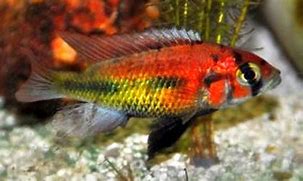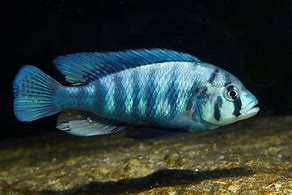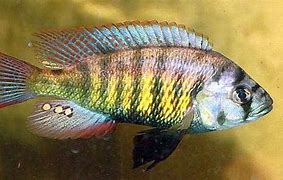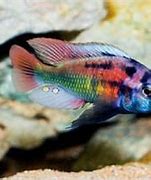Lake Victoria Cichlids
Kyoga Flameback
Size: 5 inches (13 cm.)
Description; Males are brilliantly colored with a mix of yellow. Lime green, and red. Females are usually a plain silver or gold color. Both will also have a broken lateral line and bars on their face/head. The bars on their face/head and body can come and go depending on their mood.
Scientific Name: Xystichromis “Kyoga Flameback”
Natural Habitat: The Kyoga Flameback is found in Lake Nawampassa, a lake north of Lake Victoria that is part of the Kyoga Basin/ Victorian Nile drainage system Click on the map below/left for a large map with inset of Lake Nawampassa within the greater Victorian Nile Drainage
Water Parameters: Ph 7.2-8.6 personally I would keep this number closer to 8. They prefer hard water so generally a Gh of over 200ppm is advised.
Recommended Tank Size and Temperament; 40 gallons for a colony should be the minimum size tank for these guys. Mildly aggressive, they are still definitely not community fish and should be kept with other Cichlids that are of a less aggressive nature.
Feeding; Omnivore- Foods should include both vegetable matter as well as meat. They can do fine with Paradigm Premium Custom Omnivore Diet.
Breeding; As with most African Cichlids the Kyoga Flameback will readily breed in an aquarium, provided good water parameters, and nutrition are given. The males will try to lure ripe females to a spot in the aquarium they have picked out. They do this by flashing their brilliant breeding dress and they shake and shimmy their body for the female. They usually remove any sand or gravel to make a smooth spot for the female to drop her eggs, the male will then fertilize the eggs as the female picks them up. Kyoga Flamebacks are a mouth brooding cichlid. This means the female holds the eggs in her mouth until the fry has developed and is ready to be released. It typically takes about 18 days (give or take) for the female to release the fry. At this time the fry are fully developed and ready to eat very finely crushed foods. There are fry foods out there but they are quite expensive…I have found that either frozen cyclopeez or a good flake food crushed into almost microscopic pieces work just as well.
Species Status; These fish are unfortunately IUCN red listed as endangered. Most Lake Victoria species are due to pollution and the introduction of the Nile Perch.
Contributor Notes; By Brenda (from Everything Aquatic) I came across my Kyoga’s (pronounced Choga) in an unusual way…I walked into a LFS and there they were. Apparently, they had special ordered them for someone who never showed up. Their loss, my gain. I knew what they were but never expected to just find them this way as they are pretty rare in the hobby. They are also IUCN red listed as endangered in the wild. These fish are pretty easy to keep, and they are not as aggressive as a lot of the other Lake Victoria species. I have kept mine with a variety of other fish that are classified as less aggressive. I would definitely not put them with Pundamilla or Mbuna type cichlids as these guys are way to rough for the Kyoga’s. The males when mature get beautiful colors, mixes of lime green, yellow, and red. The females are plain, as with a lot of cichlids, they are just a plain silver or goldish color. It is also not advised to keep these guys with similar looking Lake Victoria species as the females all look pretty much the same and we want to keep the species pure. They will breed with other species. If you are looking for another Lake Victoria species to keep with your Kyoga’s you could look into one’s such as the Paralabidochromis Chromogynos, as the males and females of this species are piebald (blotched) making females totally different then the Kyoga females. As far as feeding goes, I feed mine a combination of Spirulina flakes, frozen foods, and an African cichlid formulated pellet. They seem to eat anything. They are Omnivores, so you need to make sure you have a good balance of vegetable matter along with meaty food. If you are someone who wants something different or are interested in helping to save a species from extinction, I highly recommend these guys, along with many other of the species of Lake Victoria. You will not be disappointed
Description; Males are brilliantly colored with a mix of yellow. Lime green, and red. Females are usually a plain silver or gold color. Both will also have a broken lateral line and bars on their face/head. The bars on their face/head and body can come and go depending on their mood.
Scientific Name: Xystichromis “Kyoga Flameback”
Natural Habitat: The Kyoga Flameback is found in Lake Nawampassa, a lake north of Lake Victoria that is part of the Kyoga Basin/ Victorian Nile drainage system Click on the map below/left for a large map with inset of Lake Nawampassa within the greater Victorian Nile Drainage
Water Parameters: Ph 7.2-8.6 personally I would keep this number closer to 8. They prefer hard water so generally a Gh of over 200ppm is advised.
Recommended Tank Size and Temperament; 40 gallons for a colony should be the minimum size tank for these guys. Mildly aggressive, they are still definitely not community fish and should be kept with other Cichlids that are of a less aggressive nature.
Feeding; Omnivore- Foods should include both vegetable matter as well as meat. They can do fine with Paradigm Premium Custom Omnivore Diet.
Breeding; As with most African Cichlids the Kyoga Flameback will readily breed in an aquarium, provided good water parameters, and nutrition are given. The males will try to lure ripe females to a spot in the aquarium they have picked out. They do this by flashing their brilliant breeding dress and they shake and shimmy their body for the female. They usually remove any sand or gravel to make a smooth spot for the female to drop her eggs, the male will then fertilize the eggs as the female picks them up. Kyoga Flamebacks are a mouth brooding cichlid. This means the female holds the eggs in her mouth until the fry has developed and is ready to be released. It typically takes about 18 days (give or take) for the female to release the fry. At this time the fry are fully developed and ready to eat very finely crushed foods. There are fry foods out there but they are quite expensive…I have found that either frozen cyclopeez or a good flake food crushed into almost microscopic pieces work just as well.
Species Status; These fish are unfortunately IUCN red listed as endangered. Most Lake Victoria species are due to pollution and the introduction of the Nile Perch.
Contributor Notes; By Brenda (from Everything Aquatic) I came across my Kyoga’s (pronounced Choga) in an unusual way…I walked into a LFS and there they were. Apparently, they had special ordered them for someone who never showed up. Their loss, my gain. I knew what they were but never expected to just find them this way as they are pretty rare in the hobby. They are also IUCN red listed as endangered in the wild. These fish are pretty easy to keep, and they are not as aggressive as a lot of the other Lake Victoria species. I have kept mine with a variety of other fish that are classified as less aggressive. I would definitely not put them with Pundamilla or Mbuna type cichlids as these guys are way to rough for the Kyoga’s. The males when mature get beautiful colors, mixes of lime green, yellow, and red. The females are plain, as with a lot of cichlids, they are just a plain silver or goldish color. It is also not advised to keep these guys with similar looking Lake Victoria species as the females all look pretty much the same and we want to keep the species pure. They will breed with other species. If you are looking for another Lake Victoria species to keep with your Kyoga’s you could look into one’s such as the Paralabidochromis Chromogynos, as the males and females of this species are piebald (blotched) making females totally different then the Kyoga females. As far as feeding goes, I feed mine a combination of Spirulina flakes, frozen foods, and an African cichlid formulated pellet. They seem to eat anything. They are Omnivores, so you need to make sure you have a good balance of vegetable matter along with meaty food. If you are someone who wants something different or are interested in helping to save a species from extinction, I highly recommend these guys, along with many other of the species of Lake Victoria. You will not be disappointed
Neochromis Omnicaeruleus
Size: Close to 5" (12 cm.) max *Description, Ruti Island varient; Males a silvery aqua, with a small amount of red on the caudal fin, and a small amount of red in the tail. When stressed, a chessboard pattern emerges. The females are orange blotched.
Scientific Name: Neochromis Omnicaeruleus
Natural Habitat: rocky inshore areas, various collection points.
Water Parameters: Ph recommended 7.2-8.4 temperature 72-80, gh over 200 is advised
Recommended Tank Size and Temperament; larger the better. Aggressive fish, 55 gallons minimum for a colony. Females are as aggressive as the males.
Feeding; Herbivore.
I've found that a mix of Spirulina flake, Paradigm Premium Custom Herbivore Diet, along with a basic staple flake is a good general diet for them. They do require some protein in their diet.
Breeding; A harem is a must for this species. The aggression must be disbursed among a number of females. Substrate spawner, mouth brooder. The females should be removed and isolated from the main tank, as they will not be able to fight back against attacks. Hold time is 12-15 days. Excellent mothers, protecting their fry. Babies should be fed a diet of very small food (such a Hikari First Bites), finely crushed flake will suffice.
Species status: Seems to be doing well in the wild, although they are not common in the hobby.
Contributor Notes; by Barbara (Everything Aquatic) I bought these because it was suggested I would enjoy them. I truly do. The striking colors of the males mixed with the orange blotched females makes for an attractive show tank. The biggest drawback to this species is the aggression level. This can be managed with larger colonies, with a proper male to female ratio of one male to 3 females. This species is a good mix for the more aggressive species of Victorians, I would personally look at a Pundamilla species as a tank mate. I have housed them with milder fish, and while those fish are chased, they are not harmed.
Scientific Name: Neochromis Omnicaeruleus
Natural Habitat: rocky inshore areas, various collection points.
Water Parameters: Ph recommended 7.2-8.4 temperature 72-80, gh over 200 is advised
Recommended Tank Size and Temperament; larger the better. Aggressive fish, 55 gallons minimum for a colony. Females are as aggressive as the males.
Feeding; Herbivore.
I've found that a mix of Spirulina flake, Paradigm Premium Custom Herbivore Diet, along with a basic staple flake is a good general diet for them. They do require some protein in their diet.
Breeding; A harem is a must for this species. The aggression must be disbursed among a number of females. Substrate spawner, mouth brooder. The females should be removed and isolated from the main tank, as they will not be able to fight back against attacks. Hold time is 12-15 days. Excellent mothers, protecting their fry. Babies should be fed a diet of very small food (such a Hikari First Bites), finely crushed flake will suffice.
Species status: Seems to be doing well in the wild, although they are not common in the hobby.
Contributor Notes; by Barbara (Everything Aquatic) I bought these because it was suggested I would enjoy them. I truly do. The striking colors of the males mixed with the orange blotched females makes for an attractive show tank. The biggest drawback to this species is the aggression level. This can be managed with larger colonies, with a proper male to female ratio of one male to 3 females. This species is a good mix for the more aggressive species of Victorians, I would personally look at a Pundamilla species as a tank mate. I have housed them with milder fish, and while those fish are chased, they are not harmed.
Mbipia cf. Lutea
Size: 4 inches (10 cm.)
Scientific Name: Mbipia cf. Lutea
Description; Vertical stripes, with a dark horizontal stripe. Patches of orange-peach on the body and tail. My dominant male shows aqua on the top fin. Females have the same striping pattern, just not the coloration.
Natural Habitat: Lake Victoria
Water Parameters: Ph 7.2-8.4. Temperature 72-80. They prefer harder water, so a Gh of over 200 ppm is advised.
Recommended Tank Size and Temperament; 40 gallon minimum. Very aggressive fish, most aggression due to limited tank size. House with tank mates that can handle the aggression. Colony numbers should be 1 male for 3-4 females.
Feeding: This fish is a herbivore, however some protein is necessary. A Spirulina flake is a good basic staple for this fish.
Breeding: Harem breeder. Substrate spawner. Females hold the fry for approximately 2 weeks. Isolation is recommended, as these fish are hard on each other. Feed fry very small foods (such a Hikari First Bites), crushed flake or a fry food is recommended.
Species Status: These fish are endangered in the wild.
Contributor Notes: By Barbara (of Everything Aquatic) I picked up 8 tiny fry of this species. Even at this small size, they are aggressive. I started to grow them out in a 20L, which should have been large enough for their growth period. The smallest was a victim of aggression. Moving them to a 55 gallon has limited the aggression, so larger territories are recommended for this fish. They begin to develop coloration at a very young age, and I personally have a female of 1.25 inches that has held 10 fry.
Scientific Name: Mbipia cf. Lutea
Description; Vertical stripes, with a dark horizontal stripe. Patches of orange-peach on the body and tail. My dominant male shows aqua on the top fin. Females have the same striping pattern, just not the coloration.
Natural Habitat: Lake Victoria
Water Parameters: Ph 7.2-8.4. Temperature 72-80. They prefer harder water, so a Gh of over 200 ppm is advised.
Recommended Tank Size and Temperament; 40 gallon minimum. Very aggressive fish, most aggression due to limited tank size. House with tank mates that can handle the aggression. Colony numbers should be 1 male for 3-4 females.
Feeding: This fish is a herbivore, however some protein is necessary. A Spirulina flake is a good basic staple for this fish.
Breeding: Harem breeder. Substrate spawner. Females hold the fry for approximately 2 weeks. Isolation is recommended, as these fish are hard on each other. Feed fry very small foods (such a Hikari First Bites), crushed flake or a fry food is recommended.
Species Status: These fish are endangered in the wild.
Contributor Notes: By Barbara (of Everything Aquatic) I picked up 8 tiny fry of this species. Even at this small size, they are aggressive. I started to grow them out in a 20L, which should have been large enough for their growth period. The smallest was a victim of aggression. Moving them to a 55 gallon has limited the aggression, so larger territories are recommended for this fish. They begin to develop coloration at a very young age, and I personally have a female of 1.25 inches that has held 10 fry.
Christmas Fulu
Size: 4.25 inches (11 cm.) for males; slightly smaller for females
Scientific Name: Xystichromis phytophagus
Description; When the males are in breeding color, the Christmas Fulu has both red and green coloration given by many to a Christmas coloration. Often males display blue in the facial area & dorsal fin as well. However as per the picture here, much of the time the colors are quite as spectacular as shown in many widely circulated internet pictures.
The female Christmas is a flat gold color with a yellow tinge to the fins
Natural Habitat: Lake Kanyaboli which is located at the north-eastern corner of Lake Victoria. this area is an extensive papyrus swamp with an average depth of about 120 inches (3 meters)
Water Parameters: A Ph 7.5-8.2 is found in the Yala Swamp of Lake Kanyaboli. They prefer harder water, so a Gh of over 200 ppm is advised.
A temperature of about 80 F is preferred with a range of 77-90°
Recommended Tank Size and Temperament; 40 gallon minimum for one male. A larger of 2 males and up to 6-8 females can be housed in an 80 gallon aquarium or larger.
Feeding: This fish is a herbivore with a Spirulina flake or Paradigm Premium Custom Herbivore Diet as a good basic staple for this fish.
Breeding: The Xystichromis phytophagus is a polygamous maternal mouthbrooder. It is however important to keep male aggression under control during the breeding period
One male will establish dominance in the aquarium and show this by making his colors more pronounced. This male will also chase any other males present out of sight and keep the territory free from females not ready to breed. A pit will be dug out by this dominant male and he will actively start to court the ripe females
Feed fry very small foods (such a Hikari First Bites), crushed flake or a fry food is recommended.
Species Status: An endangered species and it is already considered extinct in Lake Victoria. Captive breeding is the primary source for specimens
Contributor Notes:
Scientific Name: Xystichromis phytophagus
Description; When the males are in breeding color, the Christmas Fulu has both red and green coloration given by many to a Christmas coloration. Often males display blue in the facial area & dorsal fin as well. However as per the picture here, much of the time the colors are quite as spectacular as shown in many widely circulated internet pictures.
The female Christmas is a flat gold color with a yellow tinge to the fins
Natural Habitat: Lake Kanyaboli which is located at the north-eastern corner of Lake Victoria. this area is an extensive papyrus swamp with an average depth of about 120 inches (3 meters)
Water Parameters: A Ph 7.5-8.2 is found in the Yala Swamp of Lake Kanyaboli. They prefer harder water, so a Gh of over 200 ppm is advised.
A temperature of about 80 F is preferred with a range of 77-90°
Recommended Tank Size and Temperament; 40 gallon minimum for one male. A larger of 2 males and up to 6-8 females can be housed in an 80 gallon aquarium or larger.
Feeding: This fish is a herbivore with a Spirulina flake or Paradigm Premium Custom Herbivore Diet as a good basic staple for this fish.
Breeding: The Xystichromis phytophagus is a polygamous maternal mouthbrooder. It is however important to keep male aggression under control during the breeding period
One male will establish dominance in the aquarium and show this by making his colors more pronounced. This male will also chase any other males present out of sight and keep the territory free from females not ready to breed. A pit will be dug out by this dominant male and he will actively start to court the ripe females
Feed fry very small foods (such a Hikari First Bites), crushed flake or a fry food is recommended.
Species Status: An endangered species and it is already considered extinct in Lake Victoria. Captive breeding is the primary source for specimens
Contributor Notes:




